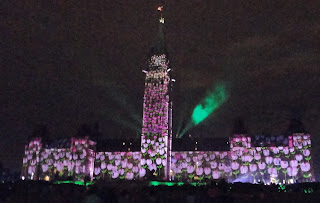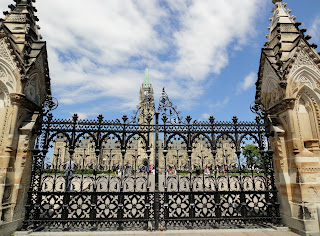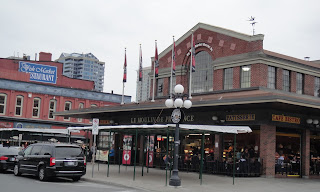When my bus arrives in Ottawa the girl I have been sitting next to on the
journey kindly offers to give me a lift downtown. My hostel is in the old jail
and my room is cell 4. It's atmospheric and a bit spooky, but I don't see or feel any ghosts.
Jail Corridor
Cell 4
Ottawa is Canada’s capital city, as chosen by Queen Victoria in 1857, which
put Montreal’s and Toronto’s noses severely out of joint. I have 3 days in
Ottawa and although it is a small city, I have to punctuate the sightseeing
with regular stops for cups of tea and muffins. I find it far more exhausting
than a good long hike.
Ottawa is a truly bi-lingual city and I hear French and English spoken
equally on the streets. The Ottawa River is the border between the provinces of
Ontario and Quebec. Ottawa sits on the Ontario side and here the information
boards and signs put English first, then French, whereas on the Quebec side the
same signs put French first.
Bridge across the Ottawa River
As I wander around the city I soak up the feeling of national pride that is
symbolised in the grand buildings, parks, monuments, statues and flags of the
city.
National, Provincial and Territorial Flags
The parliament buildings, which are home to Canada’s federal government,
sit on a hill on the banks of the Ottawa River. Construction began on
Parliament Hill in 1859 and the surrounding area was laid out as a public
garden. The original central block building burned down in 1916 and the
building here today was opened in 1920.
Gates to Parliament Hill
Parliament Central Block
In the grounds an everlasting flame was lit in 1967 to commemorate 100
years of Confederation.
Everlasting Flame
I take a free tour inside the parliament building. We go inside the House
of Commons and also the Senate Chamber. The whole thing feels and looks very
like Westminster.
Inside the Parliament
Building
House of Commons

Senate Chamber
The library is the only part of the central block building that survived
the fire of 1916. It is a beautiful round building with lots of wood and
balconies of books line the walls, but we are not allowed to take pictures
inside.
Library
We are most of the way through the tour when the fire alarm goes off and
everyone files outside. Within a couple of minutes the first fire truck
arrives. I don’t know if it was a false alarm, but the next day when I go back
everything is still standing.
Fire Evacuation
Fire Truck
The changing of the guard takes place every morning and tourists line the edges
of the grass field in front of the parliament building to watch the specatcle.
Changing of the Guard
On Parliament Hill there is a statue to 5 women who were instrumental in
the struggle of Canadian women for equality. For years groups had repeated
requested that a woman be appointed to the senate. However 5 successive Federal
Governments maintained that woman were ineligible to serve in the Senate on the
grounds that they were not ‘qualified persons’. The group of 5 woman petitioned
the Government for a definition of the word ‘persons’. In 1929 the Privy
Council finally said that ‘their Lordships have come to the conclusion that the
word ‘persons’ includes members both of the male and female sex.’ After that
women were eligible to be appointed to the Senate.
I wouldn’t argue with them – they are huge!
Women are Persons
The impact on Canada of their involvement in war including the First and
Second World Wars has not been as obvious to me up till now, as it was in New Zealand.
Their war memorials are generally not so centrally placed in the small towns I
have visited. However Ottawa remedies this through several imposing monuments
dedicated to the men and woman who have served for Canada. First of all I come
across the Peacekeeping Monument. It is inscribed with the words ‘in the
service of peace’ and ‘reconciliation’.
Peacekeeping Monument

Then there is the National War Memorial which is called ‘The Response’. It
sits calmly and quietly in a large open square centrally within the city, while
the modern life of the city swirls around it. Statues of men, women, guns and
horses struggle through an arch, from conflict towards peace. In front of it
two soldiers guard the Tomb of the Unknown Soldier.
The Response - National
War Memorial
Tomb of the Unknown Soldier
In front of the parliament building is The Peace Tower which was erected as
a monument in 1927 in memory of the service and sacrifice of the men and woman
who died serving their country in the First World War. The bells ring each
quarter hour with a Westminster chime.
Peace Tower
Views of the Ottawa River from the Peace Tower
Inside the tower the Memorial Chamber is a commemoration of those who died
in military service to Canada. It was originally designed to honour those
fallen in the First World War but it has evolved into a national memorial for
all Canadian men and women who have died serving their country during times of
both war and peace since Confederation from 1866 to the Korean War in 1953. 65
000 Canadians died in the First World War, 45 000 in the Second World War. In the
middle of the chamber is a glass cabinet containing the book of remembrance.
Around the walls are marble carvings listing all the conflicts, the number of
dead and some war poetry.
Memorial Chamber and Book of Remembrance
War has not Spared our People
Book of Remembrance
In Flanders Fields

Each evening there is a light show on Parliament Hill and tourists sit
around on the grass to watch. Light is projected onto the parliament building
and the story of Canada is told from its natural beauty and the indigenous
people; through to the modern day; the role of canada as peacekeepers and the importance of democracy and
parliament. It finishes with the National Anthem. It is very uplifting and I
feel a sense of national pride for Canada.
Light Show

Away from Parliament Hill, Byward Market is a pleasant lively area of
market stalls, cafes and bars where live music plays and people wander.
ByWard Market
Beside the Ottawa River is the National Gallery of Canada which is
currently showing a Van Goch exhibition. I think about going in, and in a way
it is a shame to miss the opportunity, but it is very busy and I decide to save
the $25.
National Gallery of Canada
Outside the gallery there is a sculpture I recognise. I’m sure there is
another one like this outside the Guggenheim in Bilbao.
Maman – by Louise Bourgeois
Across the road is an imposing cathedral, with a shiny tin roof.
Cathedral of Notre Dame
In an open-air amphitheatre outside the art gallery there is a free chambre
concerty as part of the chamber music festival.
Chamber Concert
Another square in the main shopping area also has an amphitheatre and a man sings and plays the guitar to entertain the office workers having their picnic lunches on the steps.
Square at Lunch Time
I come across a statue to a Canadian hero, Terry Fox. I had heard about him
before. He was a young man with cancer and a prosthetic leg and in 1980 he
attempted to run across Canada in support of cancer research. He completed 5373
kilometers and but had to stop and he died 10 months later. The plaque by the
statue says that ‘Terry’s heroism and determination live on in the hearts of
not only Canadians but all people worldwide who continue to pursue his dream by
raising money annually in the fight against cancer.’
Terry Fox
In the centre of the city, below Parliament Hill is the start of the Rideau
Canal. This is a 202km route linking the Ottawa River and Lake Ontario through
a system of lakes and rivers made navigable by 19 km of man-made channels, 45
locks and dams. It was completed in 1832 to create an alternative route to the
St Lawrence River as a safe route for military supplies in the case of
hostilities between Britain and the United States. It was never used for this
purpose, however it did open up the area for settlers and trade and it is now a
major recreational route.
I hire a bicycle from one of the city bike scheme stands and cycle up the
canal. It is a pleasant trip alongside the water and by the side of parks. I
share the path with other cyclists, walkers, joggers and in-line skaters. I
come to a set of locks with a lock-keeper's cottage beside it and watch four
cruisers going through.
Lock and Lock Keeper's Cottage

The canal joins the Rideau River and here I turn around and follow this
back into the city. In the parks I pass various groups enjoying the weekend.
There is a group of black men drumming, a family picnic including a baseball
game and some sort of organised fun day and the smell of a barbecue wafts
across the path. Back in the city the Rideau River joins the Ottawa River in a small
waterfall.
Beside the canal there is a photographic exhibition showing all her visits
to Canada, in celebration of the Queen’s Diamond Jubilee and flags lining the
main streets also celebrate this event. Queen Elizabeth is still the Head of
State here. Her first visit was In 1951 when she was still Princess Elizabeth
and there is a photograph of her line dancing!
Across the river on the Quebec side is the Canadian Museum of Civilisation,
depicting Canada’s cultural heritage.
As I walk back to the hostel I see some evidence of conflicting opinions
about Canada’s relationship with the monarchy. Stuck on a lamp post is a poster
which says:
‘Canada’s history hasn’t started yet. We’re still a colony’.
Someone has taken a pen and amended it to read:
“Canada’s history has started. We’re not a colony.’














































No comments:
Post a Comment